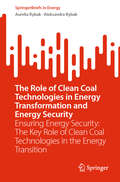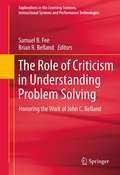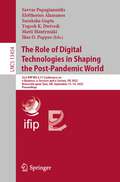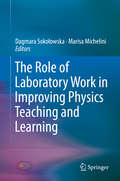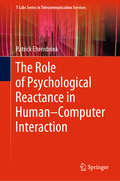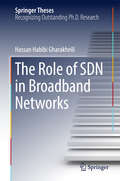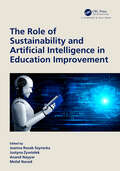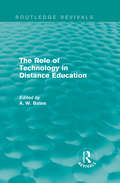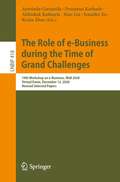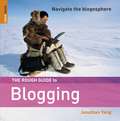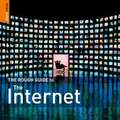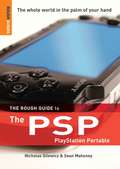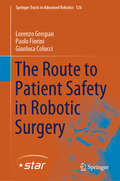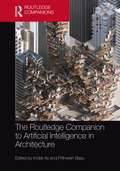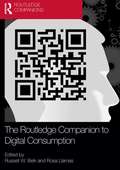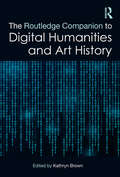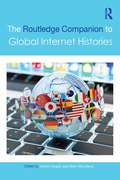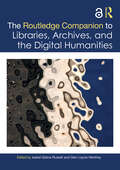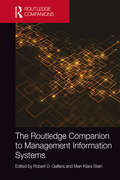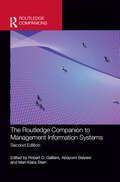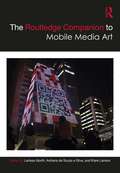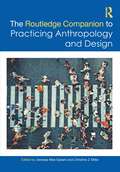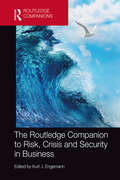- Table View
- List View
The Role of AI in Bio-Medical Translations’ Research for the Health Care Industry: First International Conference, AIBTR 2023, Nagpur, India, September 23, 2023, Revised Selected Papers (Communications in Computer and Information Science #1987)
by Sivaram Ponnusamy Vibha Rajesh BoraThis book constitutes the revised selected papers of the First International Conference, AIBTR 2023, held in Nagpur, India, during September 22–23, 2023.The 7 full papers included in this volume were carefully reviewed and selected from 37 submissions. The papers contained in this book discuss the application of Artificial Intelligence in Biomedical Engineering for the Health Care industry.
The Role of Clean Coal Technologies in Energy Transformation and Energy Security: Ensuring Energy Security: The Key Role of Clean Coal Technologies in the Energy Transition (SpringerBriefs in Energy)
by Aurelia Rybak Aleksandra RybakThis book presents the latest achievements in the field of clean coal technologies and shows how these innovations contribute to environmental protection and ensure stability of energy supplies. The book describes how clean coal technologies can revolutionize our energy future. From advanced mining methods to modern energy storage solutions, this book is a source of knowledge about sustainable development and technological innovation.
The Role of Criticism in Understanding Problem Solving
by Samuel Fee Brian BellandIn 1991, Denis Hlynka and John Belland released Paradigms Regained, a well received reader for graduate students in the field of educational technology. The Role of Criticism in Understanding Problem Solving updates some of those ideas initially proposed in Paradigms Regained, and extends the conversation into the contemporary discourse regarding problem based learning (PBL). Paradigms proposed the idea of criticism as a third method for the conduction of educational research, the first two being qualitative and qualitative. The concept of criticism as a tool for research is not well established in educational technology, although it is well established in other educational research traditions such as Curriculum Studies. Unfortunately, it is not always clear how criticism can be applied. This book views criticism as a way to step back and look at an educational intervention within educational technology through a particular critical lens. Criticism is viewed as a valuable approach to guiding meta analyses and theoretical studies, serving to prevent the proverbial "spinning of the wheels" that often happens in educational research. By indicating new potential research questions and directions, criticism approaches can invigorate educational research. This book revisits the ideals of criticism in order to establish their usefulness for studying educational technology interventions to support problem based learning. First, a few foundational chapters set the stage for the conversations on criticism. Then, the role criticism can play in enhancing analysis and interpretation of the PBL literature is explored. Finally, case studies addressing the central concepts of the text are presented and dissected. This book represents a complete overhaul and rethinking of the use of criticism as a method for understanding and furthering the research area of PBL within the field of Educational technology.
The Role of Digital Technologies in Shaping the Post-Pandemic World: 21st IFIP WG 6.11 Conference on e-Business, e-Services and e-Society, I3E 2022, Newcastle upon Tyne, UK, September 13–14, 2022, Proceedings (Lecture Notes in Computer Science #13454)
by Yogesh K. Dwivedi Matti Mäntymäki Ilias O. Pappas Suraksha Gupta Savvas Papagiannidis Eleftherios AlamanosThis book constitutes the refereed proceedings of the 21st IFIP WG 6.11 Conference on e-Business, e-Services, and e-Society, I3E 2022, which took place Newcastle-upon-Tyne, UK, in September 2022. The 37 papers presented in this volume were carefully reviewed and selected from 72 submissions. They were organized in topical sections as follows: Artificial intelligence; Data and Analytics; Careers and ICT; Digital Innovation and Transformation; Electronic Services; Health and Wellbeing; Pandemic; Privacy, Trust and Security.
The Role of Laboratory Work in Improving Physics Teaching and Learning
by Marisa Michelini Dagmara SokołowskaThis book explores in detail the role of laboratory work in physics teaching and learning. Compelling recent research work is presented on the value of experimentation in the learning process, with description of important research-based proposals on how to achieve improvements in both teaching and learning. The book comprises a rigorously chosen selection of papers from a conference organized by the International Research Group on Physics Teaching (GIREP), an organization that promotes enhancement of the quality of physics teaching and learning at all educational levels and in all contexts. The topics covered are wide ranging. Examples include the roles of open inquiry experiments and advanced lab experiments, the value of computer modeling in physics teaching, the use of web-based interactive video activities and smartphones in the lab, the effectiveness of low-cost experiments, and assessment for learning through experimentation. The presented research-based proposals will be of interest to all who seek to improve physics teaching and learning.
The Role of Psychological Reactance in Human–Computer Interaction (T-Labs Series in Telecommunication Services)
by Patrick EhrenbrinkThis book provides an in-depth investigation on the psychological phenomenon "reactance“ in the context of Human-Computer Interaction (HCI). The author argues that the complexity and autonomy of modern technology can sometimes be overwhelming and can then be perceived as a threat to freedom by its users, thereby diminishing acceptance. The book investigates if and how this is the case and provides strategies to regain the lost acceptance. Topics include relevance of reactance on HCI, triggers for reactance, consequences of reactance, measurement of reactance, and countermeasures to reactance.
The Role of SDN in Broadband Networks
by Hassan Habibi GharakheiliThis thesis focuses on the design and use of software defined networking (SDN) in residential Internet service providers (ISPs), as well as innovative operational models that can be incorporated in broadband ecosystems. Though SDN addresses the challenges for bundled best-effort service provided by broadband operators for users, it does not distinguish between the different types of applications (video streaming, web-browsing, and large file transfers), nor does it cater to the varying needs of different household devices (entertainment tablets, work laptops, or connected appliances). This is a problem for end-users, who want to differentiate between applications and devices; for content providers (CPs), who want to exercise control over streams of high monetary value; and for Internet service providers (ISPs), who have to accommodate growing traffic volumes without additional revenues. This book develops a series of solution techniques that use SDN to find an optimal balance between the competing requirements of end-users, ISPs, and CPs. In addition to the design and discussions of various architectures, it provides technical details on real-world system implementations and prototypes. As such, it offers a valuable resource for researchers, network architects, network strategists, developers, and all other readers seeking to learn more about the practical value of SDN in future ISP networks.
The Role of Sustainability and Artificial Intelligence in Education Improvement
by Anand Nayyar Mohd Naved Justyna Żywiołek Joanna Rosak-SzyrockaThis book is devoted to the issues faced by universities in the field of distance learning during and after COVID, as well as in digitalization times. The book devotes a lot of space to the issues of Web 3.0 in university e-learning, Industry 4.0, artificial intelligence and digital equity. The aim and scope of this book is to draw a holistic picture of education before and after COVID, the psychological effects of COVID in education, and using modern technologies application in education, taking into consideration aspects of sustainability development, Industry 4.0 and Society 5.0. The authors also raise the issue of artificial intelligence investigation in learner-instructor interaction. Features: • To elaborate the functions of online education and numerous pedagogical strategies based on electronic learning to aid teachers and students with the tools required to succeed in the 21st century via engaging virtual experiences• To analyze tools provided by Ed-Tech firms and the effect of digital tools on maintaining the educational process in times of crisis and after pandemic• To create a roadmap for higher education institutions and provide tips regarding how to improve the effectiveness of the hybrid learning system• To understand e-learning characteristic in the era of Industry 4.0 and Society 5.0 and characteristics of the different web generations• To use AI applications to improve connections and relationships between students and teachers and in education in the future The book is both scientific and educational. It can be used at the university level and by anyone interested in the topics it covers.
The Role of Technology in Distance Education (Routledge Revivals)
by Tony BatesThis book, first published in 1984, provides a comprehensive review of the range of technology that was being used in distance education. Technological developments in word processing, video-disc and viewdata as well as computer-based learning had revolutionised the potential for distance education. These developments required the role of more ’conventional’ distance learning media, such as broadcasting, tuition and text, to be reassessed. This book, written by international experts in the field, explored the state of the art at the time, and also provided their ideas on how future developments were likely to evolve. This book is ideal for those studying education and communications.
The Role of e-Business during the Time of Grand Challenges: 19th Workshop on e-Business, WeB 2020, Virtual Event, December 12, 2020, Revised Selected Papers (Lecture Notes in Business Information Processing #418)
by Xiao Liu Jennifer Xu Aravinda Garimella Prasanna Karhade Abhishek Kathuria Kexin ZhaoThis book constitutes revised selected papers from the 19th Workshop on e-Business, WeB 2020, which took place virtually on December 12, 2020.The purpose of WeB is to provide a forum for researchers and practitioners to discuss findings, novel ideas, and lessons learned to address major challenges and map out the future directions for e-Business. The WeB 2020 theme was “The Role of e-Business during the Time of Grand Challenges.” The 12 papers included in this volume were carefully reviewed and selected from a total of 24 submissions. The contributions are organized in topical sections as follows: Cybersecurity and COVID-19 challenges; digital platforms; and managing human factors in e-business.
The Rough Guide to Blogging
by Jonathan YangThe Rough Guide to Blogging is the ultimate reference for all things weblog. It takes you into the blogosphere, from blogging's early history and where it is today, to the future of blogs and their social and cultural impact. This book will help you to discover the greatest blogs on the web and to understand newsreaders and RSS. Whether you want to start your own blog or contribute to an existing one, this guide will teach you everything you'll need to know. Chapters include: Creating a Blog, Blog Design, Advanced Blogging, Audio and Video, Podcasting, Blogging for Money, Corporate Blogging plus much, much more. Whether you're an experienced blogger or just getting started, this is the right book for you.
The Rough Guide to eBay
by Ian PeelThe Rough Guide to eBay will transform you into a master trader at the world's biggest marketplace. Whether you're new to online auctions or you're angling to become a PowerSeller, you'll find all the expert advice you need. Buying Top bidding tactics to help you bag the best bargains, including sniping tools and more, Selling From getting the highest price from individual auctions to setting up a store, Payments Get the most from PayPal, the currency of eBay, Security The low-down on scams, rules, payments, insurance and legal issues, The Story The history, legends and subsidiaries of the world's greatest website, There's far more to eBay than meets the eye. The Rough Guide to eBay reveals all.
The Rough Guide to the Internet
by Peter Buckley Duncan ClarkWritten in plain English, this book covers everything from getting online for the first time to newsfeeds, Internet telephony and advanced tips and tricks guaranteed to turn casual surfers into Net gurus. This fully revised guide covers all the latest sites and crazes, including Skype, blogging, myspace and other social networks and online video. Whether you've never sent an email or you just want to keep up with the latest developments, this is the book for you.
The Rough Guide to the Play Station Portable
by Nicholas Gilewicz Sean MahoneyThe Rough Guide to the PSP is the ultimate handbook to Sony's hugely successful hand-held games console. From the basic buying and operating instructions to downloading and listening to music, this guide helps the reader to understand the technical processes of tweaking the PSP and to perform operations never dreamed of by Sony. It explains how to: Find the right model and get the best deal Explore the best online sites and forums Play movies, music, and games with the Universal Media Disc Fully exploit the PSP's WiFi functionality Downgrade firmware and run homebrew applications Use emulators to play classic games Maximize the potential of the memory stick Extend your PSP with software and hardware accessories Plus much, much more. . . Whether you're an experienced gamer or just getting started, this is the book for you.
The Route to Patient Safety in Robotic Surgery (Springer Proceedings in Advanced Robotics #126)
by Lorenzo Grespan Paolo Fiorini Gianluca ColucciThe introduction of a new technology in a consolidated field has the potential to disrupt usual practices and create a fertile ground for errors. An example is robotic surgery that is now used in most surgical specialties, pushed by technology developers and enthusiastic surgeons. To analyze the potential impact of robotic surgery on patient safety, a consortium of major European Universities started the project SAFROS whose findings are summarized and further elaborated in the three parts of this book. Part one describes safety in complex systems such as surgery, how this may disrupt the traditional surgical workflow, how safety can be monitored, and the research questions that must be posed. Part two of the book describes the main findings of this research, by identifying the risks of robotic surgery and by describing where its ancillary technologies may fail. This part addresses features and evaluation of anatomic imaging and modeling, actions in the operating room, robot monitoring and control, operator interface, and surgical training. Part three of the book draws the conclusions and offers suggestions on how to limit the risks of medical errors. One possible approach is to use automation to monitor and execute parts of an intervention, thus suggesting that robotics and artificial intelligence will be major elements of the operating room of the future.
The Routledge Companion to Artificial Intelligence in Architecture
by Imdat As and Prithwish BasuProviding the most comprehensive source available, this book surveys the state of the art in artificial intelligence (AI) as it relates to architecture. This book is organized in four parts: theoretical foundations, tools and techniques, AI in research, and AI in architectural practice. It provides a framework for the issues surrounding AI and offers a variety of perspectives. It contains 24 consistently illustrated contributions examining seminal work on AI from around the world, including the United States, Europe, and Asia. It articulates current theoretical and practical methods, offers critical views on tools and techniques, and suggests future directions for meaningful uses of AI technology. Architects and educators who are concerned with the advent of AI and its ramifications for the design industry will find this book an essential reference.
The Routledge Companion to Digital Consumption (Routledge Companions in Business, Management and Accounting)
by Russell W. Belk Rosa LlamasThe first generation that has grown up in a digital world is now in our university classrooms. They, their teachers and their parents have been fundamentally affected by the digitization of text, images, sound, objects and signals. They interact socially, play games, shop, read, write, work, listen to music, collaborate, produce and co-produce, search and browse very differently than in the pre-digital age. Adopting emerging technologies easily, spending a large proportion of time online and multitasking are signs of the increasingly digital nature of our everyday lives. Yet consumer research is just beginning to emerge on how this affects basic human and consumer behaviours such as attention, learning, communications, relationships, entertainment and knowledge. The Routledge Companion to Digital Consumption offers an introduction to the perspectives needed to rethink consumer behaviour in a digital age that we are coming to take for granted and which therefore often escapes careful research and reflective critical appraisal.
The Routledge Companion to Digital Humanities and Art History (Routledge Art History and Visual Studies Companions)
by Kathryn BrownThe Routledge Companion to Digital Humanities and Art History offers a broad survey of cutting-edge intersections between digital technologies and the study of art history, museum practices, and cultural heritage. The volume focuses not only on new computational tools that have been developed for the study of artworks and their histories but also debates the disciplinary opportunities and challenges that have emerged in response to the use of digital resources and methodologies. Chapters cover a wide range of technical and conceptual themes that define the current state of the field and outline strategies for future development. This book offers a timely perspective on trans-disciplinary developments that are reshaping art historical research, conservation, and teaching. This book will be of interest to scholars in art history, historical theory, method and historiography, and research methods in education.
The Routledge Companion to Global Internet Histories (Routledge Media and Cultural Studies Companions)
by Mark Mclelland Gerard GogginThe Routledge Companion to Global Internet Histories brings together research on the diverse Internet histories that have evolved in different regions, language cultures and social contexts across the globe. While the Internet is now in its fifth decade, the understanding and formulation of its histories outside of an anglophone framework is still very much in its infancy. From Tunisia to Taiwan, this volume emphasizes the importance of understanding and formulating Internet histories outside of the anglophone case studies and theoretical paradigms that have thus far dominated academic scholarship on Internet history. Interdisciplinary in scope, the collection offers a variety of historical lenses on the development of the Internet: as a new communication technology seen in the context of older technologies; as a new form of sociality read alongside previous technologically mediated means of relating; and as a new media "vehicle" for the communication of content.
The Routledge Companion to Libraries, Archives, and the Digital Humanities (Routledge Companions to the Digital Humanities)
by Isabel Galina Russell Glen Layne-WortheyThe Routledge Companion to Libraries, Archives, and the Digital Humanities covers a wide range of issues encountered in the world’s libraries and archives as they continue to expand their support of, and direct engagement in, Digital Humanities (DH) research and teaching. In addition to topics related to the practice of librarianship, and to libraries and archives as DH-friendly institutions, we address issues of importance to library and archives workers themselves: labour, sustainability, organisation and infrastructure, and focused professional practices that reflect the increasingly important role of librarians and archivists as active research partners. One of the central motifs of this book is that the “two” fields—DH, on the one hand, and the library, archival, and information sciences on the other—are in fact deeply intertwined, productively interdependent, and mutually reinforcing. We place these on an equal footing, considering how they coexist and collaborate in equal partnership.This Companion will be of interest to DH practitioners and theorists, especially those who work in libraries and archives, and those who work with them. Likewise, “non-DH” (or “not-yet-DH”) library and archival administrators, reference and public service librarians, cataloguers, and even those who work primarily with the tangible collections will find here echoes and implications of the most venerable traditions and practices of our shared profession.The Introduction of the book is free-to-view at https://www.book2look.com/book/hpV4zdnW6q.Chapter 14 of this book is freely available as a downloadable Open Access PDF at http://www.taylorfrancis.com under a Creative Commons Attribution-Non Commercial-No Derivatives (CC-BY-NC-ND) 4.0 license.Chapter 17 of this book is freely available as a downloadable Open Access PDF at http://www.taylorfrancis.com under a Creative Commons Attribution-Non Commercial-No Derivatives (CC-BY-NC-ND) 4.0 license.Chapter 8 and 18 will be made Open Access.
The Routledge Companion to Management Information Systems (Routledge Companions in Business, Management and Accounting)
by Robert D. Galliers Mari-Klara SteinThe field of Information Systems has been evolving since the first application of computers in organizations in the early 1950s. Focusing on information systems analysis and design up to and including the 1980s, the field has expanded enormously, with our assumptions about information and knowledge being challenged, along with both intended and unintended consequences of information technology. This prestige reference work offers students and researchers a critical reflection on major topics and current scholarship in the evolving field of Information Systems. This single-volume survey of the field is organized into four parts. The first section deals with Disciplinary and Methodological Foundations. The second section deals with Development, Adoption and Use of MIS – topics that formed the centrepiece of the field of IS in the last century. The third section deals with Managing Organizational IS, Knowledge and Innovation, while the final section considers emerging and continuing issues and controversies in the field – IS in Society and a Global Context. Each chapter provides a balanced overview of current knowledge, identifying issues and discussing relevant debates. This prestigious book is required reading for any student or researcher in Management Information Systems, academics and students covering the breadth of the field, and established researchers seeking a single-volume repository on the current state of knowledge, current debates and relevant literature.
The Routledge Companion to Management Information Systems (Routledge Companions in Business, Management and Marketing)
by Robert D. Galliers Mari-Klara Stein Abayomi BaiyereThe field of information systems has been evolving since the first application of computers in organizations in the early 1950s. Focusing on information systems analysis and design up to and including the 1980s, the field has expanded enormously, with our assumptions about information and knowledge being challenged, along with both intended and unintended consequences of information technology.This second edition takes stock of the progress made in recent years and presents a forward-looking perspective that can help to shape future scholarly conversations both in the field of information systems but also in cognate fields where information technology is having profound effects. With the advances in digital technology, such as artificial intelligence, the Internet of Things, cloud computing, blockchain, green tech and the like, we herald a digital era and can envision a shift and a need for new logics – “new ways of thinking” and new ways of engaging with digital technology now and in the near future. As compared to the four themes in the previous edition, this book introduces a fifth theme, “Digital Phenomena”, to specifically attend to contemporary issues and what is a pertinent agenda for future research. This prestige reference work offers students and researchers a critical reflection on major topics and current scholarship in this evolving field, with each chapter providing a balanced overview of current knowledge, identifying issues and discussing relevant debates.This book is required reading for any student or researcher concerned not just with the broad - and expanding - field of management information systems per se but all those in cognate disciplines interested in the impacts, management and use of modern information technologies in organizations and modern society, whether it be strategy, organizational behaviour, marketing, sociology or the like. This single-volume repository deals not just with the current state of knowledge, the current debates and the extant literature, but also with questions concerning emerging management concerns and implications of the fast-changing world of digital technologies.
The Routledge Companion to Mobile Media Art (Routledge Media and Cultural Studies Companions)
by Larissa HjorthIn this companion, a diverse, international and interdisciplinary group of contributors and editors examine the rapidly expanding, far-reaching field of mobile media as it intersects with art across a range of spaces—theoretical, practical and conceptual. As a vehicle for—and of—the everyday, mobile media is recalibrating the relationship between art and digital networked media, and reshaping how creative practices such as writing, photography, video art and filmmaking are being conceptualized and practised. In exploring these innovations, The Routledge Companion to Mobile Media Art pulls together comprehensive, culturally nuanced and interdisciplinary approaches; considerations of broader media ecologies and histories and political, social and cultural dynamics; and critical and considered perspectives on the intersections between mobile media and art. This book is the definitive publication for researchers, artists and students interested in comprehending all the various aspects of mobile media art, covering digital media and culture, internet studies, games studies, anthropology, sociology, geography, media and communication, cultural studies and design.
The Routledge Companion to Practicing Anthropology and Design
by Jenessa Mae Spears Christine Z MillerThe Routledge Companion to Practicing Anthropology and Design provides a comprehensive overview of the history of the relationship between these two fields and their current state, outlining key concepts and current debates as well as positing directions for future practice and research. Bringing together original work from a diverse group of established and emerging professionals, this volume joins a wider conversation about the trajectory of this transdisciplinary movement inspired by the continuing evolution of anthropology and design as they have adapted to accelerating and unpredictable conditions in arenas that span sectors, economies, socio-cultural groups, and geographies. It homes in on both the growing convergence and tensions between them while exploring how individuals from both fields have found ways of mixing, experimenting, and evolving theory and new forms of practice, highlighting the experimental theories and practices their transdisciplinarity has generated.The Routledge Companion to Practicing Anthropology and Design is a valuable reference tool for practitioners, scholars, and upper-level students in the fields of anthropology and design as well as related disciplines.
The Routledge Companion to Risk, Crisis and Security in Business (Routledge Companions in Business, Management and Accounting)
by Kurt J. EngemannAware that a single crisis event can devastate their business, managers must be prepared for the worst from an expansive array of threats. The Routledge Companion to Risk, Crisis and Security in Business comprises a professional and scholarly collection of work in this critical field. Risks come in many varieties, and there is a growing concern for organizations to respond to the challenge. Businesses can be severely impacted by natural and man-made disasters including: floods, earthquakes, tsunami, environmental threats, terrorism, supply chain risks, pandemics, and white-collar crime. An organization’s resilience is dependent not only on their own system security and infrastructure, but also on the wider infrastructure providing health and safety, utilities, transportation, and communication. Developments in risk security and management knowledge offer a path towards resilience and recovery through effective leadership in crisis situations. The growing body of knowledge in research and methodologies is a basis for decisions to safeguard people and assets, and to ensure the survivability of an organization from a crisis. Not only can businesses become more secure through risk management, but an effective program can also facilitate innovation and afford new opportunities. With chapters written by an international selection of leading experts, this book fills a crucial gap in our current knowledge of risk, crisis and security in business by exploring a broad spectrum of topics in the field. Edited by a globally-recognized expert on risk, this book is a vital reference for researchers, professionals and students with an interest in current scholarship in this expanding discipline.

